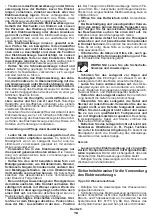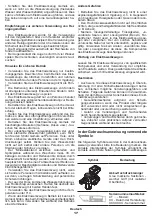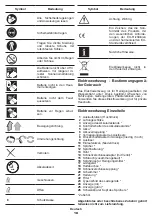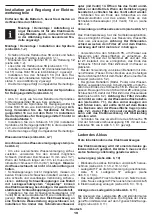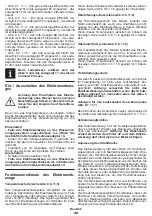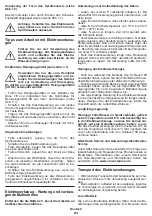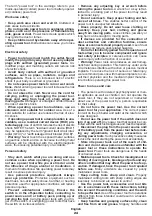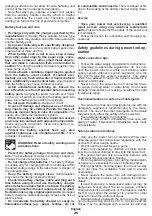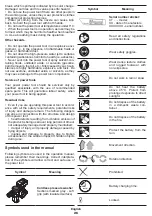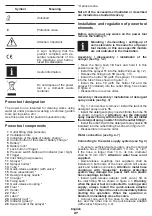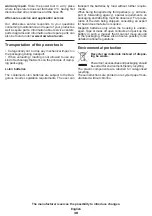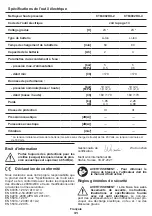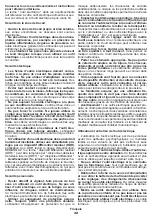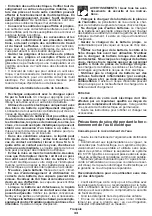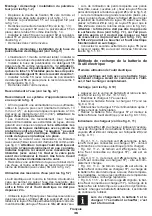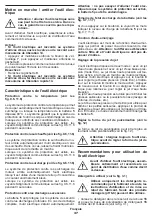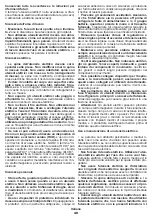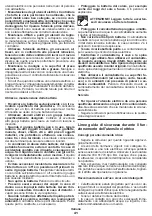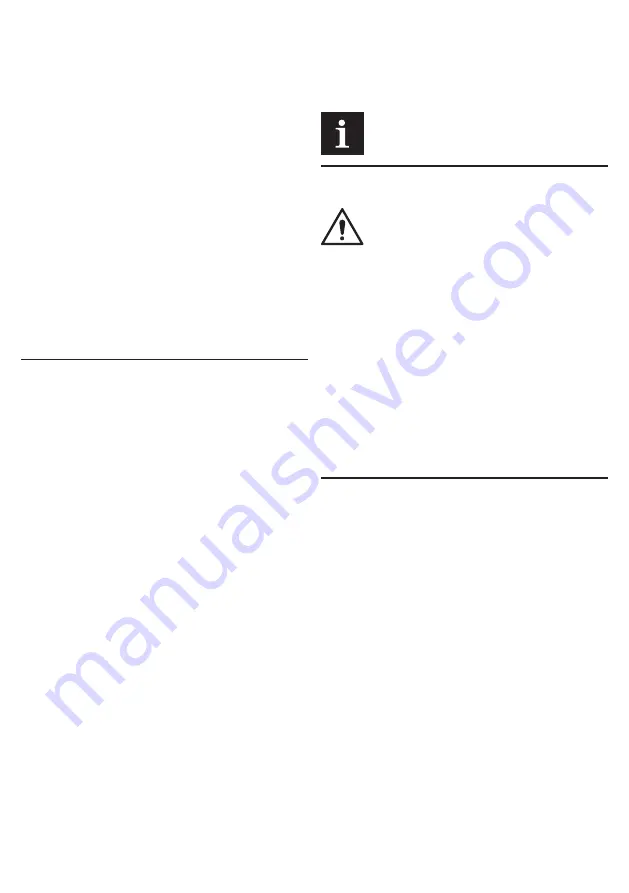
28
English
Using water reservoirs (see fig. 5-7)
The power tool has the self-priming function that
allows to draw water from reservoirs, water bodies,
etc�
Attention: the elevation difference between the
filter 22 and the power tool must not exceed 2 m.
•
Use the hose
15
to draw water from reservoirs or
water bodies� The hose
15
has the float
20
and the
holder
21
installed which allow to correctly place the
end of the hose
15
with the filter
22
in water�
•
When using small containers with thin walls (barrels,
buckets, basins, etc�), fasten the hose
15
to a container
wall using the holder
21
(see fig. 5.2).
•
When using large reservoirs (baths, pools) or water
bodies, use the float
20
to adjust position of the end
of the hose
15
in water. Move the float
20
along the
hose
15
for the filter
22
to stay in the water column
(see fig. 6.2).
Attention: the filter 22 should not be
too close to the surface of water (see fig. 7.1) as it
can lead to draw of air, and should not lie on the
bottom of reservoir or water body (see fig. 7.2) as
the filter 22 may become clogged, and the power
tool will work with overload.
•
Connect the second end of the hose
15
(with the
quick-release coupling
19
) to inlet fitting
10
as shown
in fig. 5.1, 6.1.
Charging procedure of the power tool
battery
Initial operating of the power tool
The power tool is supplied with a partially charged
battery 5. Before the first use, the battery 5 must
be fully charged.
Charging process (see fig. 8, 10)
•
Press the battery lock
6
and remove the battery
5
(see fig. 8.1-8.2, 10.1-10.2).
•
Connect the charger
17
to the power supply�
•
Insert battery
5
into charger
17
(see fig. 8.4, 10.4).
•
Disconnect the charger
17
from power supply after
charging�
•
Remove the battery
5
from the charger
17
� Insert
the battery
5
into the power tool (see fig. 8.3, 10.3).
Charger indicators (see fig. 9, 11)
Charger indicators
24
and
25
inform of the battery
5
charging process� Signals of the indicators
24
and
25
are shown on the label
23
(see fig. 9, 11).
•
Fig� 9�1, 11�1 - (the green indicator
25
is on, the
battery
5
is not inserted in the charger
17
) - the
charger
17
is connected to the power network (ready
for charging)�
•
Fig� 9�2, 11�2 - (the green indicator
25
is blinking, the
battery
5
is inserted in the charger
17
) - the battery
5
is being charged�
•
Fig� 9�3, 11�3 - (the green indicator
25
is on,
the battery
5
is inserted in the charger
17
) - the
battery
5
is fully charged�
•
Fig� 9�4, 11�4 - (the red indicator
24
is on, the battery
5
is inserted in the charger
17
) - the charging process
of the battery
5
is terminated due to inappropriate
temperature� When the temperature conditions are
normal, the process of charging will resume�
•
Fig� 9�5, 11�5 - (the red indicator
24
is blinking, the
battery
5
is inserted in the charger
17
) - the charging
process of the battery
5
is terminated because of its
failure� Replace the faulty battery
5
, its further use is
prohibited�
In the process of charging the battery 5
and the charger 17 become hot, it is a
normal process.
Switching the power tool on / off
Attention! switching the power tool on
without water can cause its breakage. In
this case you lose the right to warranty
repair.
Before turning the power tool on, perform the assembly
operations and connect the power tool to water supply
as described above�
Switching on:
•
If the power tool is connected to the water sup-
ply system, open the valve on the quick-release
adapter 14.
•
Press and hold the lock button
7
, then press and
hold the trigger
9
�
•
Water under pressure will start to come from the
nozzle of the sprayer
11
within 30 seconds�
Switching off:
•
Release the trigger
9
�
•
If the power tool is connected to the water
supply system, close the valve on the the quick-
release adapter 14.
Design features of the power tool
Temperature protection (see fig. 9.6, 11.6)
The temperature protection system enables to
automatically deactivate the power tool in case of
excess load or when the temperature of the battery
5
is
exceeding 80°C� The system guarantees protection of
the power tool from damage in case of noncompliance
with the operation conditions�
When this protection system is activated
indicators
3
will blink as shown onto fig. 9.6, 11.6 dur
-
ing 3 seconds�
Overheating protection (see fig. 9.6, 11.6)
Overheating protection system of the engine automati-
cally switches off the power tool in case of overheat-
ing� In this situation, let the tool cool before turning the
power tool on again�
When this protection system is activated indicators
3
will blink as shown onto fig. 9.6, 11.6 during 3 sec
-
onds�
Overload protection (see fig. 9.6, 11.6)
Overload protection system of the engine automatically
switches off the power tool when it is operated in a
manner that causes it to draw an abnormally high
current�
Summary of Contents for CT63002HX
Page 1: ......
Page 5: ...5 ...
Page 6: ...6 ...
Page 7: ...7 ...
Page 8: ...8 ...
Page 9: ...9 ...
Page 10: ...10 ...
Page 11: ...11 ...
Page 12: ...12 ...
Page 13: ...13 ...
Page 159: ...159 ...
Page 160: ...160 ...
Page 161: ...161 ...
Page 162: ...162 ...
Page 163: ...163 ...
Page 164: ...164 ...
Page 165: ...165 ...
Page 166: ...166 ...
Page 167: ...167 ...
Page 168: ...168 ...
Page 169: ...169 ...
Page 170: ...170 ...
Page 171: ...171 ...
Page 172: ...172 ...
Page 173: ...173 ...
Page 174: ...174 ...
Page 175: ...175 ...
Page 176: ......



